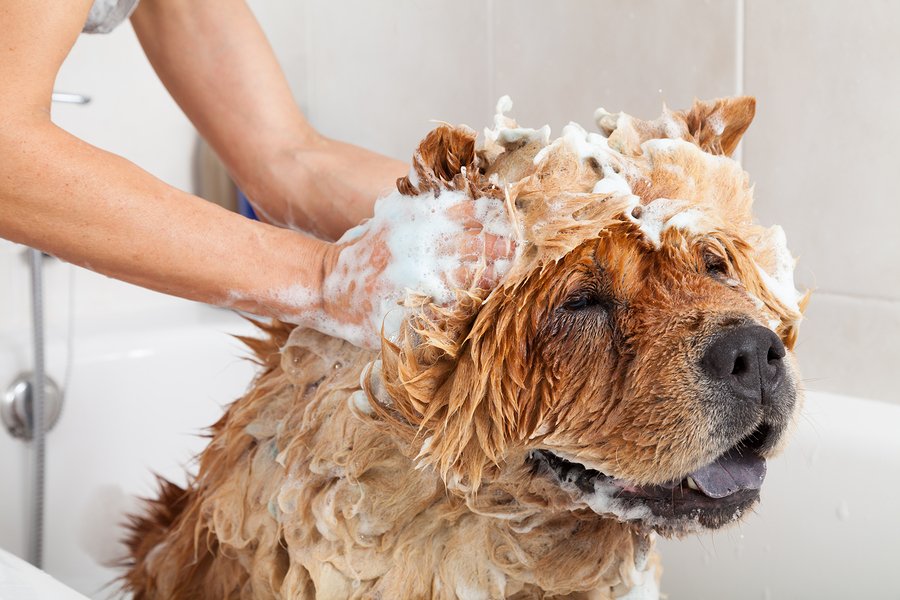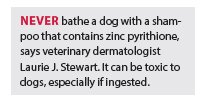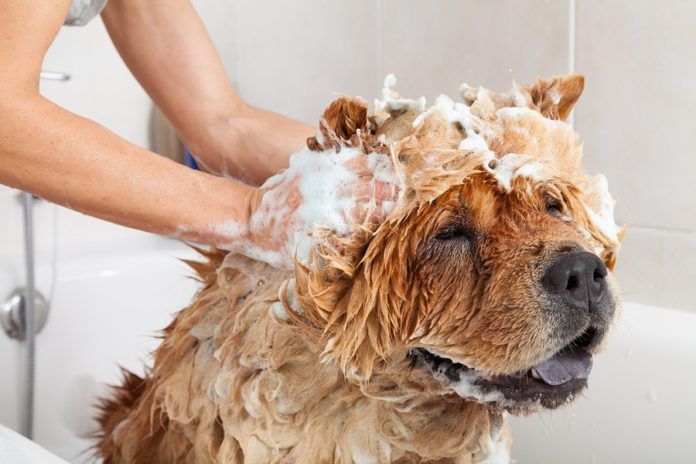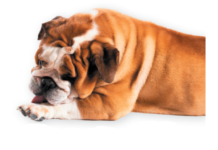Bigstock

“Dogs love to dig in and roll in the dirt and run through the woods, and though they don’t like to go out in the rain will gladly jump in a swamp or smelly debris,” says veterinary dermatologist Laurie J. Stewart, VMD, DACVD. Maybe that’s why Dr. Stewart, owner of Veterinary Dermatology of New England in Westford, Massachusetts, quips that “bathing in dogs is highly underrated.”
Truth be told, healthy dogs who are free of skin disease don’t need to be bathed for their own sake. Oils on their skin and hair retain moisture, and scents they pick up along the way help them communicate with other dogs about where they’ve been and what they’ve been up to. But they sure need to be bathed for our sake — they rest on our furniture, sleep on our beds, and, sometimes, stink under our noses.
There are other good reasons to bathe a dog periodically — anywhere from every few months to as often as once a week, a frequency that veterinary dermatologists concur is permissible in most cases. One of them is that more frequent hands-on tub time allows owners to more easily “find lumps and growths…they can feel the skin better when the coat is wet and they are massaging the shampoo” in, Dr. Stewart points out. Crusting and rashes may become more apparent, too.
Bathing also removes loose hairs that need to fall out anyway, meaning less hair in our homes.
How to make it easier on the dog Water temperature is critical, Dr. Stewart says. Dogs do not like a hot, sauna-like shower nor a cold one that we might find refreshing. The water should be kept warm instead, perhaps a bit tepid even.
You may also want to gently place cotton balls in your dog’s ears to prevent water from accumulating. (Always remember to take them out after the bath.) In fact, Dr. Stewart says, avoid spraying water in your dog’s face at all. Instead, use a warm facial cloth to “gently clean the face without shampoo and thereby protect the eyes,” the doctor advises.
Never use a shampoo meant for people, not even a baby shampoo said to be gentle or soothing or emitting a baby-friendly scent. It’s not gentle enough. Our skin is significantly more acidic than dogs’ skin and can handle shampoos with a different pH balance. What it means is that a shampoo meant for humans can strip the protective acidic mantle on a dog’s skin that keeps viruses and bacteria from permeating. Using shampoo meant for humans can even lead to a smelliness caused by infiltrating bacteria. And that, unfortunately, leads some concerned owners to wash their dogs with even greater frequency with the very shampoo that allowed the proliferation of bacteria that caused the odor. Aside from the bacteria problem, stripping the protective mantle from your dog’s skin can leave him feeling itchy and irritated. Such shampoos may be drying, especially if your pet is already prone to dry skin.

“Shampoos formulated for dogs are best,” Dr. Stewart says, and products with oatmeal, fatty acids, aloe, and non-soap hypoallergenic ingredients” are good bets. She advises against shampoos to which fragrances that linger have been added, saying that only scents given off by the ingredients in the product to begin with are what’s best for dogs.
Rinse thoroughly. If you don’t make sure to get out all the suds and the shampoo remains stuck in the hair coat, it can lead to infection. Shampoo is not supposed to hang around on a dog’s body.
After bathing, if your dog can manage a dryer, make sure it’s one that’s intended for dogs only and provides non-heated, high-volume air. Heated dryers should not be used because dogs’ skin is literally thinner than ours — the heat can hurt. Heated dryers on cages have even been known to cause burns — and worse.
How to make it easier on you Kneeling over a tub, especially if you have back problems, can be hard — harder still if your dog is not cooperative at bath time. If that describes your situation, consider a do-it-yourself dog-washing station at a pet store. The tubs are raised, which makes reaching your pet much easier, and all the muss and fuss — the wetness, the dirty towels, and so on — stay there instead of in your bathroom for you to clean up. “Do-it-yourself dog washes are great,” says Dr. Stewart. “They have ramps that the dog walks up to get into the tub with doors on the sides for safety,” which means you don’t have to lift a potentially struggling pet over the side.
Here are some other suggestions for making bathing easier, especially for a reluctant dog.
RESTRAINTS It may be that you can lead your dog to the tub with his leash, but if keeping him in place means struggling with one hand on the lead as you try to maneuver sudsing and rinsing with the other, you might want to consider restraints, or tethers, which help hold your dog in the tub and prevent him from backing up into the sides of the bathtub or stall.
Pro Guard Dog Grooming Stay-N-Wash Tub Restraint has a 19-inch cable that can be attached to your pet’s collar or harness and kept secure with rubber suction cups that adhere to the shower stall or tub wall. Costs about $10.50.
Rinse Ace Bathing Tethers come with nylon straps and two suction cups to attach to either side of the tub or stall. The straps adjust from 15 to 24 inches. Costs about $9.00.
SHOWER SPRAYS Your own shower spray may not be long enough to reach all the way under your dog’s belly or can in other ways make it difficult to use on your pet. The following may make good alternatives and come with other attractive features, too.
Uarter Pet Bath Sprayer Dog Shower has a four-foot hose that comes with a universal connector so you can wash your dog in or out of the house, provided there is running water available. The gizmo also comes with a massage feature that assists with the cleaning while providing a relaxing sensation for your dog. The massaging shower head has a shampoo container attachment and a water lock button so you can spray shampoo or water or stop either function with your free hand. Costs about $20.00.
MIU PET Multi-Functional Dog Shower comes with a four-foot ($18.99) or seven-foot ($20.99) hose, and allows a combined usage for shampooing, massaging, and rinsing.
Kleen Freak Deluxe Pet Shower and Dog Wash Bundle has an eight-foot hose and comes with a 15-by-31-inch plastic bath mat to keep your dog from slipping and sliding in sudsy water. Also included: a 24-by-39-inch microfiber towel for drying off, a plastic drain guard to keep loosened fur from stopping up your drain, a brass adapter and two-way shower connection, a brush that can be used on both wet and dry fur, and a water-pausing feature on the shower head for when you momentarily need to stop the flow. Costs about $48.00.
DEMATTING TOOLS FOR IN OR OUT OF THE SHOWER Along with removing mats, tangles, and loose hair from your dog, these tools can also help slough off dead skin cells. And they feel good to a dog, provided you minimize tugging at fur and make sure the teeth of the rake, comb, or brush have rounded ends to prevent scraping of the skin. Before brushing, give your dog’s skin a good once-over to make sure you will not be combing against broken or irritated skin or, say, an embedded tick.
Pat Your Pet Extra-Wide Dematting Comb rakes out mats and tangles and helps reduce shedding. The dual head has nine teeth on one side for more determined tangles, which can be used and then followed up with the other side, which has 17 teeth to thin your dog’s fur and remove loosened hair. The rounded, rust-proof stainless steel teeth on the device manage to massage without scraping, instead only removing some of the undercoat. Anti-slip handle makes for easier use. Costs about $20.00.
PawsPampers Undercoat Rake for Dogs comes with sharpened, 1.38-inch stainless steel rounded teeth blades to remove loose hair, knots, and undercoats. Works best on dogs with thick coats — not intended for thin-haired pets. The wooden handle is a little more than seven inches long. Costs about $25.00.
Oster Professional Pet Grooming Undercoat Rake shapes, thins, and finishes off your dog’s undercoat (and overall coat) safely with rounded ends on its 18-teeth rake. Works best on large, long-coated dogs. Costs about $17.00.
FURminator Dog Rake has rounded, rotating pins that remove tangles and works to take out matting from a dog’s undercoat without tugging or skin irritation. Costs about $6.00.
Safari Dematting Comb is a stainless steel tool for removing mats and tangles from dogs with medium, long, and coarse hair. The blades can be reversed for easier use among lefties. Costs about $8.00.





